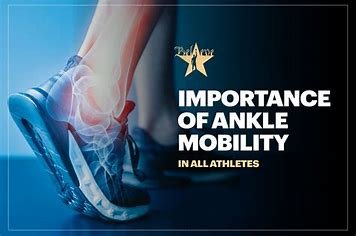Ankle mobility plays a crucial role in running, influencing everything from your stride length to your overall form and efficiency. If your ankle mobility is limited, it can affect your running performance and increase your risk of injury.

1. Improved Stride Mechanics
- Dorsiflexion (the ability to bring your toes toward your shin) and plantar flexion (the ability to point your toes downward) are critical for an efficient running stride.
- Good ankle mobility allows for a full range of motion, which is essential for proper foot placement and the ability to push off the ground effectively.
- If you lack ankle mobility, your stride may shorten, and you’ll have to compensate with other parts of your body, potentially leading to inefficient running form.
2. Enhanced Propulsion and Power
- During running, the ankle plays a key role in the push-off phase (from the toe). A mobile ankle allows for a better stretch-shortening cycle (SSC), meaning you can efficiently store and release energy as your foot pushes off the ground.
- Restricted ankle movement can hinder your ability to generate the necessary force, making you less powerful and potentially slower.
3. Increased Stability and Balance
- Ankle mobility also impacts the ability to maintain balance during running. A stiff or immobile ankle can result in instability, especially on uneven terrain or when running at high speeds.
- The ankle joint needs to be able to adapt to changes in surface and provide stability with each footstrike. Limited mobility can make the foot roll inward or outward, increasing the risk of sprains and other injuries.
4. Shock Absorption and Impact Management
- When you land during running, the ankle joint needs to absorb shock and properly dissipate the impact force. With adequate mobility, the ankle can move in a way that distributes this force more efficiently, reducing stress on the knees, hips, and lower back.
- If the ankle lacks flexibility, it may force other parts of the body to absorb this shock, increasing the likelihood of overuse injuries, like shin splints or knee pain.
5. Improved Posture and Alignment
- Ankle mobility is also linked to the position of the foot and how it affects the rest of the body. If your ankle has restricted motion, you might adjust your running posture, which could lead to poor alignment in your knees, hips, and lower back.
- Proper ankle mobility allows for better alignment and body mechanics, which improves overall posture during running and reduces the risk of strain or discomfort.
6. Prevention of Injury
- Limited ankle mobility can increase the risk of common running injuries, such as:
- Plantar fasciitis: Limited ankle dorsiflexion can increase tension on the plantar fascia.
- Achilles tendinitis: Reduced flexibility can cause excessive stress on the Achilles tendon.
- Shin splints: Poor ankle mobility can contribute to compensatory movements that place extra stress on the shins.
- Ankle sprains: Ankle stiffness can make it harder to adapt to changes in terrain, leading to a greater risk of rolling or spraining the ankle.
Key Areas Affected by Ankle Mobility:
- Dorsiflexion: Crucial for proper foot clearance and efficient stride mechanics.
- Plantar Flexion: Important for strong push-offs and overall propulsion.
- Eversion and Inversion: Involves the foot’s ability to tilt inward or outward, essential for shock absorption and proper foot positioning during running.
How to Improve Ankle Mobility:
To optimize ankle mobility for running, incorporate these exercises into your routine:
- Ankle Dorsiflexion Stretch:
- Place your foot flat on the floor and gently push your knee forward over your toes. This helps improve flexibility in the front of the ankle.
- Ankle Circles:
- Sit or stand and rotate your ankle in circles, both clockwise and counterclockwise. This increases circulation and flexibility in the ankle joint.
- Calf Stretch:
- Stretch your calf muscles by standing and placing your hands on a wall while extending one leg behind you. Keeping the back heel flat on the floor, lean forward to stretch the calf and improve ankle flexibility.
- Lunge with a Twist:
- Perform a lunge while twisting your torso to the side. This helps increase ankle flexibility while also stretching your hips and improving balance.
- Standing Heel Raises:
- Stand tall and rise up onto your toes, then lower back down. This strengthens the calf muscles and improves plantar flexion range of motion.
- Band-Assisted Ankle Mobility:
- Use a resistance band to gently pull your foot into dorsiflexion while maintaining tension on the band. This helps improve the mobility of the ankle joint.
Conclusion:
Ankle mobility is fundamental for running efficiency, power, and injury prevention. Limited mobility in the ankle can result in poor running form, inefficient movement, and a higher risk of injury. By incorporating mobility exercises and stretches into your routine, you can improve your range of motion, enhance your performance, and reduce the likelihood of running-related injuries.
